… This is how Leonardo da Vinci does all his paintings, for example the head of Lisa del Giocondo and of Anne, the mother of the Virgin. We will see what he is going to do in the hall of the Great Council, for which he has just reached an agreement with the Gonfaloniere. October 1503
From such a recent, chance discovery, art historians could confirm that Leonardo was painting a version of the Mona Lisa by 1503, earlier than many had previously thought, and that her identity was definitely the Florentine noblewoman Lisa del Giocondo.
Leonardo’s works were the subject of public spectacle as well as private reflection. By 1500 he was a celebrity, whose every move was watched and gossiped about. It was a major event when a new Leonardo was finished and unveiled to the general public, akin to the opening weekend of a blockbuster film today. Vasari wrote that when a new cartoon of St Anne was put on display in Florence for two days in 1501 (incidentally the first show of a single drawing in the history of Western art), ‘it attracted to the room where it was exhibited a crowd of men and women, young and old, who flocked there as if they were attending a great festival, to gaze in amazement at the marvels he had created’.
There are only two Leonardos that were undocumented in his lifetime: the Portrait of a Musician in the Ambrosiana in Milan, which art historians tend to think is by Leonardo’s assistant Giovanni Antonio Boltraffio, and the St Jerome , whose authenticity has never been questioned and for which certain probable references can be found. Both of these paintings were made relatively early in Leonardo’s career. There is no Leonardo painting executed after 1496 which is not remarked in contemporary sources – except, perhaps, one now.
No records from the artist’s lifetime, or for a further hundred years after it, mention Leonardo painting a Salvator Mundi . This is all the more surprising because of the significance of the subject matter. The Christ which Leonardo painted in his Last Supper is the subject of a long anecdote in Vasari’s Lives of the Artists . He relates how Leonardo went to see his client, the Duke of Milan, and provided a progress report on The Last Supper , explaining that he had still not yet painted Christ’s head because ‘he was unwilling to seek a model on earth and unable to presume that his imagination could conceive of the beauty and celestial grace required of divinity incarnate’.
If the greatest artist of his times was painting the greatest subject in Christian art, a Salvator Mundi, one would expect to find it recorded in a note in a monk’s chronicle or a secretary’s letters, at the very least. The absence of such documentation is the first great mystery of the Salvator Mundi . It compels art historians to rely on their ‘superpower’, ‘the eye’, alone. The name of the artist and the date of execution of this painting can only be determined by analysis of the style, technique and motifs of the work, but the result of such a process will always lack the certainty of proof.
Leonardo never dated any of his paintings, but on stylistic and technical grounds, the Salvator Mundi can be placed in the second half of his career, beginning after 1500 and ending with his death in 1519. The preparatory drawings must have been made in the early years of the sixteenth century because they are executed in Leonardo’s softer red chalk style. They are usually dated 1502–10. The painting itself has the intense sfumato shading of the second phase of Leonardo’s work, beginning in the sixteenth century. The walnut wood used for the panel points to a date after 1506, when Leonardo returned to Milan. Walnut was a relatively unusual choice in Renaissance Florence, but was widely used by Milanese painters. It is difficult to be more precise, because Leonardo worked on many of his pictures for a long time, painting them slowly, sometimes on and off over a decade or more, occasionally returning to them after an intermission, often never finishing them. The scientific means of dating a panel painting by analysing the rings in the wood, dendrochronology, cannot be used with walnut, because the rings are too widely spaced to give more than the vaguest indication of epoch.
Whatever the day was when the first brushstrokes were applied to the Salvator Mundi , Leonardo had by then become one of the most celebrated living artists of the Italian Renaissance, alongside Botticelli, Piero della Francesca, Raphael, Michelangelo, Giovanni Bellini, Andrea Mantegna and a dozen others. He had progressed from artistic child prodigy to gifted studio assistant, then a master painter with his own practice in Florence, and later official court artist, the grandest position a Renaissance artist could rise to in Milan, where he also worked as a sculptor, engineer, set designer and architect. But his career had also had challenging periods when work and money were in short supply.
Born in 1452 in Vinci, a village on the outskirts of Florence, Leonardo was the illegitimate son of a notary, Ser Piero, and a local farmer’s daughter, Caterina di Meo Lippi. His early life was both privileged and disadvantaged. Ser Piero was well-to-do, with a number of properties including a farm in Vinci. By the time Leonardo was in his late teens his father also had offices in the Bargello in Florence, where he offered his legal services to clients from important monasteries and Florentine businesses. But having been born out of wedlock, Leonardo seems not to have received the classical education that a family of Piero’s standing would normally have given their son. He grew up not having learned Latin or Greek, and occasionally referred to that lack in his notebooks. He called himself an ‘unlettered man’, and once signed himself ‘Leonardo da Vinci, disciple of sperentia ’, which means both experience and experiment, Renaissance Italian for the ‘school of life’. For the introduction of his planned treatise on painting, which he never published himself, he drafted this opening paragraph:
I am fully aware that my not being a man of letters may cause certain presumptuous people to think that they may with reason blame me, alleging that I am a man without learning. Foolish folk! … They strut about puffed up and pompous, decked out and adorned not with their own labours, but by those of others … They will say that because I have no book learning I cannot properly express what I desire to describe – but they do not know that my subjects require experience rather than the word of others.
Leonardo had the Renaissance version of a chip on his shoulder. He turned this weakness into a strength by approaching his subjects without preconceptions or precepts, making the blank page the starting point for enquiry and creativity.
Fifty kilometres east of Vinci lay the ochre and red assemblage of roofs, domes, towers and crenellations of Florence, where the Renaissance was under construction. The dome of Florence cathedral, designed by Brunelleschi, built without scaffolding out of four million bricks, still the largest masonry dome in the world, was nearing completion; Leonardo was to be involved in its finishing touch, a gleaming bronze ball placed atop the lantern in 1472. Luca della Robbia was filling lunettes and decorating sarcophagi with his ceramic reliefs of pretty Madonnas and characterful saints, smoothly glazed in bright green, blue, white and yellow. In the evenings the low sunlight caught Ghiberti’s Gates of Paradise , a door with ten scenes from the Old Testament, cast in bronze but looking like burnished gold, completed in 1424 and given its popular name by an admiring Michelangelo. It was a beacon to the future of art, with its energetic crowd scenes full of billowing robes and flailing limbs, set within the arches and atria of monumental classical backdrops.
Читать дальше












